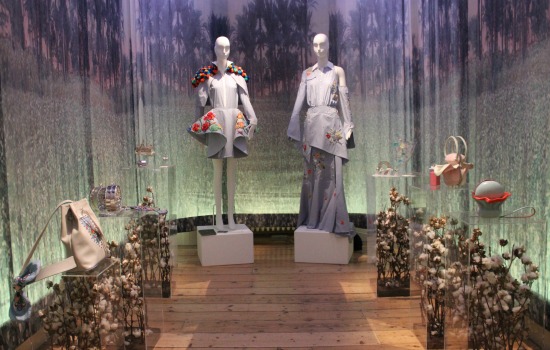
Curator Susan Sabet at the Egyptian display at London Fashion Week (Photo: Ati Metwaly)
Friday saw the start of the British leg of the fashion week calendar, exhibiting the work of creative talents on 50 catwalks and 30 presentations for five glamorous days.
The International Fashion Showcase (IFS) was launched in 2012 by the British Fashion Council along with the British Council as part of fashion and cultural cooperation.
Ahram Online talks with the curator of the Egyptian Exhibition Susan Sabet, the founder and editor-in-chief of Pashion magazine, about Egypt being the only Arab country in IFS this year. The designers participating in the exhibition are: Norine Farah (womenswear), Reem Jano (jewellery), Sabry Marouf (handbags and jewellery), Marsuma by Nour Omar (textiles painting), Okhtein (handbags) and Maram Paris (womenswear).
Sabet explains how the installation '100% Egyptian Cotton' is a manifestation of the IFS' 2017 theme; local/global.
Q: Why did you choose the "100% Egyptian cotton" term?
The theme the British Council gave us this year is local/global, so we thought the best thing to interpret local/global is the term 100% Egyptian cotton, because it is rooted in Egyptian history and has been the major income from the early 19th century financing the building of the Suez Canal and downtown Cairo.
Globally, it is a sign of excellence, the best quality cotton. Furthermore, right now there’s a crackdown on fake Egyptian cotton, it’s a very hot topic. Many suppliers worldwide put on the label, but it is not real.

Egyptian display at London Fashion Week (Photo: Ati Metwaly)
This has also spurred our government to increase production of long staple cotton, and apparently it is already expecting a double or triple yield this year.
Our interior set [and fabric placed as a backdrop to the display] was designed by Living in Interiors. They used an image dated from between the 1950s to the 70s. It is just a 2x3 cm image of a cotton field. They gave it to a young artist called Omar Marei, who opened it on Illustrator [editing programme] and add graininess and an oil paint effect to give it its texture.
So they enlarged the image digitally and gave it to a printing house in Menoufiya that does all the work for Shahira Fawzy of Sahara printing, who donated 100% Egyptian voile that she grows herself. The piece was printed with natural biological colours. It gets boiled in a solution that has glue and binder and then gets put in an oven so they colour sets and the fabric settles.
We chose the light effect behind it to give the feeling of from Morning till Night, so we have morning, noon, dusk and night. Our accessory designers and jewellery designers were inspired by the life cycle, from the cotton bud till the ready product.
Q: How did you get to participate?
This is the fifth year the British Council has done this initiative, where they invite countries to participate with a cultural installation, with the work of emerging fashion designers. The ambassador accepted and appointed me as the curator, and this is the second year for us.
I selected the designers based on certain criteria. They should not have had more than five years in the business and their work should be able to compete internationally, design-wise and quality-wise. Also they have to be able to work as a team, because it is not about the designer, it is about the country. It all has to blend.
I think you walk into our display and know where you are, and if you read the title 100% Egyptian cotton, you need no explanation. It is very clear and straightforward, and I think that for us local/global was the best theme to take.
Q: How do you evaluate young Egyptian designers in general?
The design scene has been booming in Egypt, and this is the moment now for young designers. It is probably a combination of growing social media, which has pushed forward and boosted their work.
They also have a reach through social media, and of course the devaluation of the pound, which has made imports so expensive, gives young local designers an edge [in Egypt].
Short link: